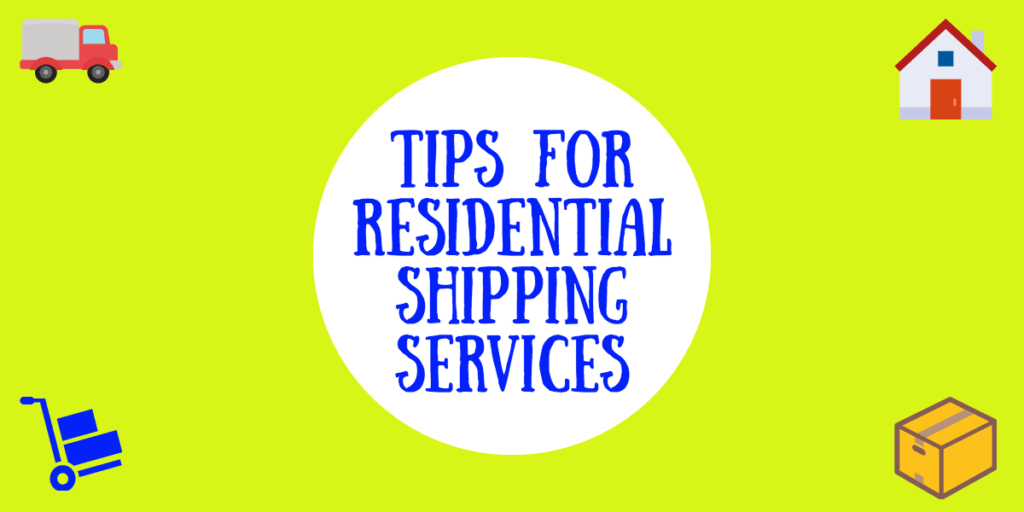
Getting freight picked up from or delivered to a residence is different when shipping LTL than when you’re shipping small package with UPS or Amazon. Part of this has to do with the size of most LTL freight shipments. LTL shipments are rarely a cardboard box that can be left on a doorstep.
More often than not they are palletized and weigh over 100lbs. The second has to do with the size of the truck delivering or picking up the freight. Residential streets are often small and not equipped to accommodate a semi-truck.
Because of these LTL shipping aspects, if you need something picked up from or delivered to a residence you’ll need to pay the additional services fee for LTL Residential Delivery or Residential Pickup. All freight carriers are different, so check with your freight broker for pricing.
Unfortunately one charge does not cover both pickup and residential delivery. As pickup will be handled by one terminal, and delivery handled by another terminal (and sometimes even a different carrier due to interlining) residential delivery is a separate charge from residential pickup.
You Will Need a Liftgate
The other thing to keep in mind for residential freight services is that you’ll probably need a Liftgate for both pickup and residential delivery. LTL carriers are not moving companies, so they will not take freight to the front door. If you’re having freight picked up at a residence you’ll need to have the freight palletized and on the street so the driver can easily get the freight on to the truck.
Unless you have a forklift or the freight is small, you’ll need a liftgate to help get the freight on or off the back of the truck. Some carriers do not charge for liftgate fees and some do, however if you are charged for a liftgate you’ll need one for both pickup and residential delivery.
Residential Pickups/Delivery Fees
A residential delivery fee is an additional service offered by the freight carrier for any and all shipments that are picking up or delivering to a residence. As LTL shipping uses dry vans and larger trucks, sometimes it can be difficult to maneuver residential streets. Both pickup and delivery will be separate charges for most carriers – so there will be a residential pickup charge as well as a residential delivery charge. This charge fluctuates depending on what freight carrier you are using to move your shipment, so ask your freight broker how much residential fees will be before you ship. If you’re quoted with residential pickup/delivery before you ship, the information will be on the Bill of Lading used at pickup. If you are having LTL freight delivered to a residence, make sure that you’ve selected the Residential Delivery additional service, as well as a Destination Liftgate. When creating the BOL, make sure you put the street address and contact information for the resident in the Special Instructions where it’s clearly visible and legible. The carrier will need to call and make a delivery appointment with the resident, and without correct contact information delivery delays can occur.
Residential Delivery & Appointments
Before the freight carrier makes a residential delivery or pickup, they will call the shipper/consignee to confirm the pickup or delivery time window. Because residences are not proper businesses, their hours fluctuate more than the standard 8 AM to 5 PM offices. This makes it vital to have the correct contact’s name and phone number on the BOL. It’s important to note the appointment for residential freight because this will add an extra day of transit in most instances, and possible further delays if the carrier can’t get in touch with the shipper/consignee to set the appointment. Setting the delivery appointment can only be done by the carrier, and is included in the residential charge, making it different from a notify consignee accessorial.
Inside Delivery
A common misconception with residential LTL shipping is that the freight carrier is a moving company, and will come into your house, pack up what you need to move, and put it on their truck. This is false. LTL freight carriers are NOT white glove movers. Because of liability issues, LTL carriers and their drivers cannot enter a residence under any circumstances. For residential shipping, the freight must be packaged and on the street or porch for the carrier to handle the freight. However, there is an additional service that can be paid for called Inside Delivery. Contrary to its name, the freight carrier STILL cannot take the freight inside your house. Instead, Inside Delivery can be used to pick up or deliver freight to a porch or garage – closer to the house than the street or curb.
The Home Office
In today’s world, many people work from their home office. But in LTL shipping the physical address determines whether a location is residence or business. So even though you run your business out of your home, the freight carrier considers that location a residence, and the residential pickup/delivery fee will apply. Be sure to let your freight broker know if your business location is a residential address. This will help avoid any shipping delays.
Standard protocol for LTL shipping is business to business and dock to dock. This does not mean that they can’t deliver or pick up from a residence, it just means that you’ll need to pay for some additional services and make sure you have all the necessary contact information on the BOL used at the time of pickup.
Residential Delivery / Residential freight services in LTL shipping are not things you should be afraid of, and a few simple steps will go a long way to ensuring your freight moves successfully.





















